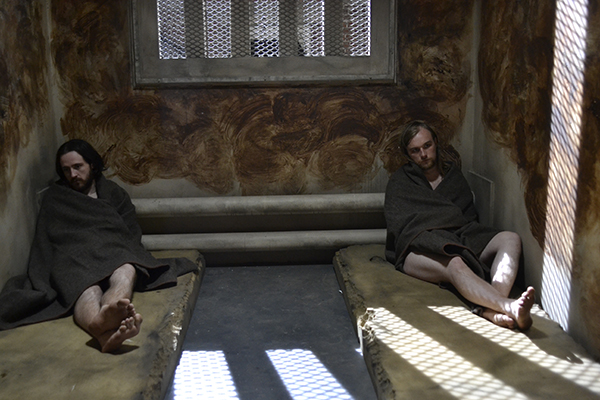Bobby Sands: 66 Days
Published in Issue 6 (November/December 2016), Reviews, Volume 24Cyprus Avenue/Fine Points Films, directed by Brendan J. Byrne
By Breandán Mac Suibhne

Above: Bobby Sands—if indeed he became an artist (according to Fintan O’Toole), for many he never ceased to be a soldier.
‘Translations, in fact, is not a history play at all’, he wrote in July 1996, when it was opening at the Abbey. ‘It is a myth about the past invented for contemporary political purposes … a self-conscious historical myth …’
There is a certain irony, then, in the fact that in Bobby Sands: 66 Days—a film promising ‘a probing personal portrait that separates man from myth’—Brendan J. Byrne accords O’Toole an opportunity to conjure a myth of his own while reducing Republicans who knew Sands to ‘this-happened-that-happened’ continuity announcers. In other words, Republicans largely give accounts; O’Toole provides the spinal analysis. The film opens with O’Toole describing Sands’s protest as ‘drama at the absolute rawest edge’, and, before it ends with the voice of an actor, representing Sands, reciting a verse of his ‘The Rhythm of Time’, it is he who strikes its closing note:
‘Bobby Sands effectively marked the end of the tradition of armed struggle in Ireland, because what he said was there is really no justification and no need to kill people, what you really need to do is dramatize your own suffering … he changed the nature of how people should think about how they force political change …’
In short, 66 Days represents Sands as one who stopped being a soldier and became an artist. The argument has merit, and O’Toole has interesting things to say, but the implication that the Hunger Strikes led to peace in our time inflicts bruises on history. Certainly, the election of Sands and then his election agent, Owen Carron, to Westminster—and hunger striker Kieran Doherty and fellow prisoner Paddy Agnew to Leinster House—strengthened those arguing that Republicans should involve themselves in electoral politics. But the Hunger Strikes also invigorated the IRA. It was more resourceful and more resilient after 1981, possessed of weaponry that would have made the eyes of its pre-Hunger Strikes volunteers water. And Sands’s death was a little closer in time to the Provisionals’ rise ‘out of the ashes of 1969’ than it was to their transformative cessation in 1994. Indeed, in 2005, when they finally put away their guns, a child born in 1981 was closing on Sands’s 27 years—and roughly of an age (23–25) with most of the dead hunger strikers. Seen in that perspective, the film’s emphasis on Sands having changed the nature of struggle suggests, per Seamus Mallon, that the Provies were slow learners. And that is, indeed, a simplistic view of history.
The ‘simplicities’ of 66 Days are scarcely ‘dangerous’, as O’Toole represented Friel’s depiction of nineteenth-century map-makers, but they are nonetheless distortions. At the very least, occluding the extent to which the Hunger Strikes invigorated the IRA diminishes the achievement of those who steered it to cessation and decommissioning. It would have been better if Byrne had finished 66 Days with reflections by the Republicans on the medium- and long-term significance of Sands, and contemplated the idea that, for many, he who became an artist never ceased to be a soldier. Certainly, the end of the film needed more voices.

Above: A scene depicting two ‘blanket-men’ on the ‘dirty protest’.
If the film’s interpretation of Sands’s significance is partial and incomplete, the promise of a ‘personal portrait’ is unfulfilled. Indeed, Byrne quickly abandons any pretence of a ‘personal portrait’ and settles instead on a history of Sands’s protest; the documentary is 66 Days not 27 Years. There were, it seems, difficulties to be surmounted in making a personal portrait. One is that Sands’s family, for personal and/or political reasons, did not participate. Thus there are limits to the personal insights that Byrne can offer, although many, if not most, historical biographers do not have recourse to their subjects’ families. People are products of society, culture and politics, and one strategy in constructing biographies of ‘ordinary people’ in the past is to illuminate the forces that made them. But here Sands—who, just by leaving a corpus of reminiscences, was far from ordinary—is a product only of political events. And the impression of a monolithic Catholic community, proudly standing behind their men in the 1970s, is not one any historian credits.

Above: Although no craw-thumper and critical of his church, Sands was a ‘believer’, when many city boys of his age and politics were not.
Greater attention to popular culture in the Belfast of Sands’s youth would have been welcome; certainly, a ‘personal portrait’ would give consideration to Catholicism and changing social mores in the city in the 1960s and 1970s. Of many glimpses in 66 Days of the film’s failure to illuminate the world that shaped Sands, Danny Devenny’s reference to women emerging after his death to say the Rosary and sing Faith of our Fathers was particularly arresting. Although no craw-thumper and critical of his church, Sands was a ‘believer’, when many city boys of his age and politics were not; and his religiosity might have been probed, given the resonance of hungering for justice for Catholics, an issue which O’Toole flags, and the various interventions by churchmen in the Hunger Strikes.
66 Days is a stylish production, and it includes some insightful contributions. The film does not live up to its billing, however, and its ending is 21st-century politics, not late twentieth-century reality.
Breandán Mac Suibhne lectures in history at Centenary University, New Jersey.
















